Why selfies aren’t going anywhere anytime soon


- Technological advancement, namely phones with self-facing cameras, allowed selfies to become a part of pop culture.
. - Social media created a space where selfies could flourish.
.
- Selfies changed significantly over the years and became more socially engaged.
.
- Gen Z takes more selfies than any other generation.
.
- The majority of people use filters and editing tools before posting their selfies online.
Two decades ago, something remarkable happened in photography. We began sharing our lives in a whole new way. We started taking lots of photos not just of our friends and places we visited, but of ourselves. Since then, selfies have become a part of our digital culture.
Although the term “selfie” is relatively new, the desire to capture our own selves has deep historical roots. From medieval and Renaissance painters subtly including themselves in group portraits to the heavily filtered and curated selfies we see today, self-portraits have always been more than just a depiction of appearance. They have served as a means of self-discovery, a way to identify with our culture and society, and even a tool for redefining our identity and challenging societal norms.
But selfies aren’t just about personal expression. They have also become a way to insert ourselves into the online world. And much overlooked as we put ourselves out there: our privacy and security. While examining selfie culture, we also look at ways to protect your privacy, including the benefits of using a VPN app or a VPN router—both of which can help keep your real location private from social platforms.
Join us as we explore the evolution of selfies, uncovering the latest trends and discovering how to protect your data when sharing your images online.

The evolution of selfies
The concept of the selfie has come a long way since its humble origins in 1839 when Robert Cornelius captured the world's first photographic self-portrait. However, it wasn't until the advent of smartphones, particularly those equipped with front-facing cameras, that selfies truly took off and became ingrained in our culture.
The first selfies
The early days of selfies saw their emergence as profile pictures on platforms like MySpace. These initial selfies, by today's standards, were often low-quality photos taken in front of mirrors with mobile phones that didn’t have internet access. Since they were primarily used as profile pictures on emerging social media platforms, early selfies were carefully posed and included mainly users’ faces
Social media as a catalyst
In the early 2000s, alongside the advancements in mobile phone technology, social media platforms began to flourish, creating a space where people could share their personal moments and contribute to the growing online culture. This was the catalyst for the birth of the modern selfie as we know it, with the infamous “duck face” look and other offshoots like the sparrow face and fish gape face emerging.
Golden era
The mid-2010s marked a golden period for selfies. In 2013, "selfie" was crowned the word of the year by the Oxford Dictionary, solidifying its cultural significance. A year later, the term “selfie” reached its peak interest—it was more searched on Google than at any other time—with social media platforms like Instagram and Facebook becoming inundated with diverse trends and challenges. Accompanying this surge in popularity was the introduction of selfie-taking gadgets, including selfie sticks and ring lights. Meanwhile, celebrities began embracing selfie culture in a big way, with major selfie moments including Ellen Degeneres’s Oscar selfie, the #wokeuplikethis craze, and Kylie Jenner’s Met Gala bathroom selfie.
Backlash against selfies
In the quest for innovative selfie-taking methods, some individuals ventured into dangerous and even illegal territories. The rise of rooftop selfies and selfies with wild animals posed significant risks. Selfie sticks have even been banned in certain tourist destinations, whether for safety (as in museums) or because they pose such a nuisance. Sadly, selfie-related injuries and deaths continue to grow as some risk their lives to get the “perfect” shot—raising the question of whether our digital-age vanity has gone too far.
Activism and body positivity era
In the late 2010s, more and more, people started leveraging selfies to express their political affiliations and support social causes like #metoo and the #icebucketchallenge, as well as amplifying the voices of minority groups and promoting charitable causes.
Selfies then shifted towards showcasing authenticity, featuring no makeup looks, promoting body positivity, employing fewer filters, and avoiding staged poses. Two recent selfie trends, namely “0.5” selfies (where people take candid pictures using the 0.5 lens built into the back of their phones which means you can’t see the result until you’ve taken it) and “traffic mirror” selfies (taking distorted selfies using their reflection in a convex mirror), aim to embrace imperfection and document the moment in its raw form.
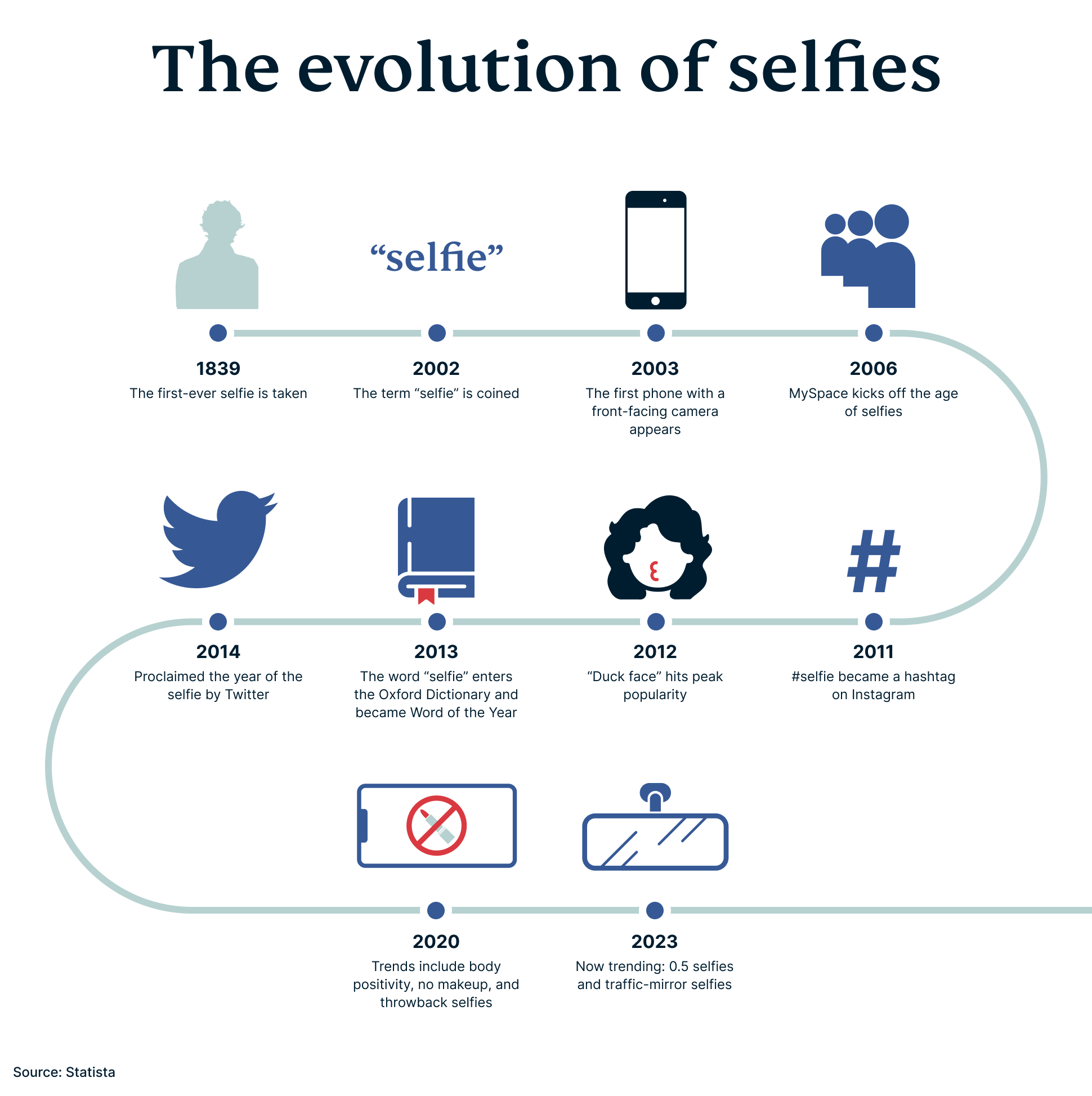
Gen Z take more selfies than any other generation
According to a recent report by Eksposure, a photography and design resource company, every day approximately 93 million selfies are captured worldwide. That's a lot of pouting and peace signs! While millennials popularized the trend, Gen Z has taken it to the next level, taking more selfies than any other age group.
A recent study reveals that Gen Z takes, on average, 3.16 selfies a week—which is almost 2.5 times as many selfies as millennials who take an average of 1.37 selfies per week. Gen Z is also responsible for trending poses, such as the “smize” (smiling eyes instead of a toothy grin), “0.5” selfies, and the “traffic mirror” selfie.
Additionally, women take more selfies than men among every generation except boomers, who don’t take that many selfies, to begin with, but with men taking slightly more than women—0.5 selfies per week vs. 0.4 selfies per week, respectively.
Gen Z takes the most selfies of any male generation (2 on average per week), but Gen Z women take the crown by taking more than 4 selfies each week. This is twice as many as millennial women, who take 1.5 selfies per week, and Gen X females who take 1 selfie per week.
| Generation | Female | Male |
| Gen Z (Born 1997 - 2012) | 4.08 | 2.23 |
| Millennials (Born 1981 - 1996) | 1.54 | 1.19 |
| Gen X (Born 1965 - 1980) | 0.98 | 0.66 |
| Baby Boomers (Born 1946- 1964) | 0.41 | 0.53 |
Source: Shiny smile
The Philippines is the country that takes the most selfies, followed by the U.S.
When it comes to who’s taking the most selfies where, according to recent statistics from Eksposure, the Philippines leads the way. For every 100,000 people in the city of Pasig, which takes the number one spot on the list, 258 are snapping self-portraits regularly. This is followed by Manhattan, New York, in the U.S. where 202 in 100,000 people are selfie-takers, and Miami, Florida, where 155 people in 100,000 claim to snap a selfie.
In fact, statistics from several years ago revealed that 62% of people in the U.S. had taken a selfie at some point in their lives. The youngest age group, 18 to 34, had the most selfie-takers, with 82% having taken one. Among people 35 to 54, 63% had taken a selfie, while 44% of those 55 and above had done so.
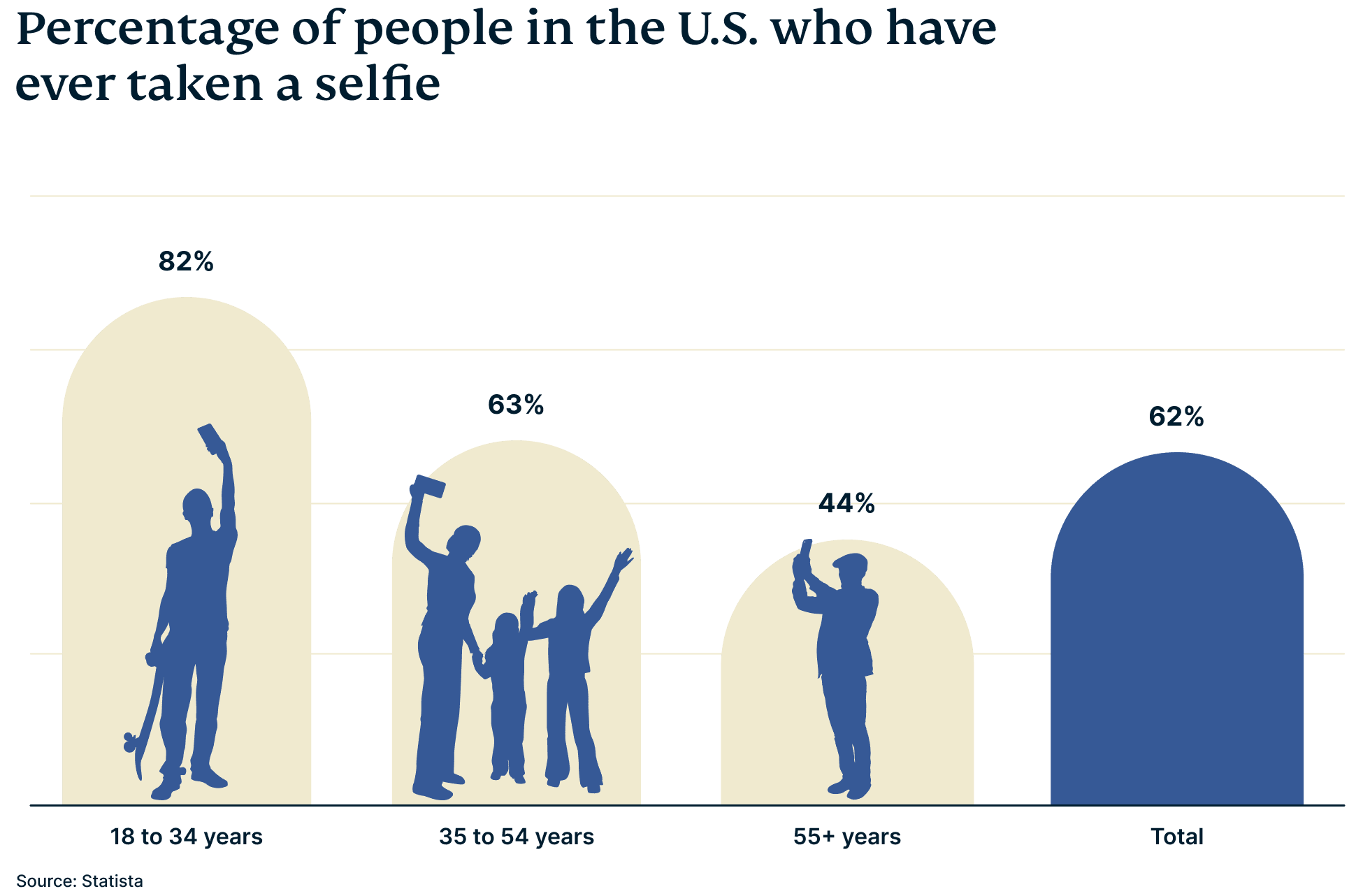
The psychology of selfies and their impact on mental health
In the era of social media, the selfie has become a ubiquitous form of self-expression. It has sparked countless debates and generated both admiration and criticism. Many argue that selfies are a manifestation of narcissism or a desperate cry for attention. However, a closer look reveals a different picture (no pun intended).
A study conducted at The Ohio State University challenges the prevailing notion that selfies are solely driven by narcissistic tendencies. The research shows people tend to take a picture of a scene if they want to convey the meaning of an event, whereas if they include themselves in the picture, it’s because they want to remember the physical experience of the event.
Meanwhile, the impact of selfies and social media on mental health remains a topic of debate. The media often portrays selfies and exposure to social media as culprits responsible for plummeting mental well-being. Yet, research on this topic presents a more nuanced view. For example, a study conducted by the University of London found that while 12% of people felt that social media negatively impacted their self-esteem, 10% reported that it actually boosted their confidence.
The relationship between selfies, self-esteem, and mental health is complex, however. A study involving over 3,000 respondents from the UK revealed that a staggering 71% of individuals are unwilling to share a photo of themselves online without editing it first. The reliance on editing tools highlights the desire to present a perfected version of oneself online.
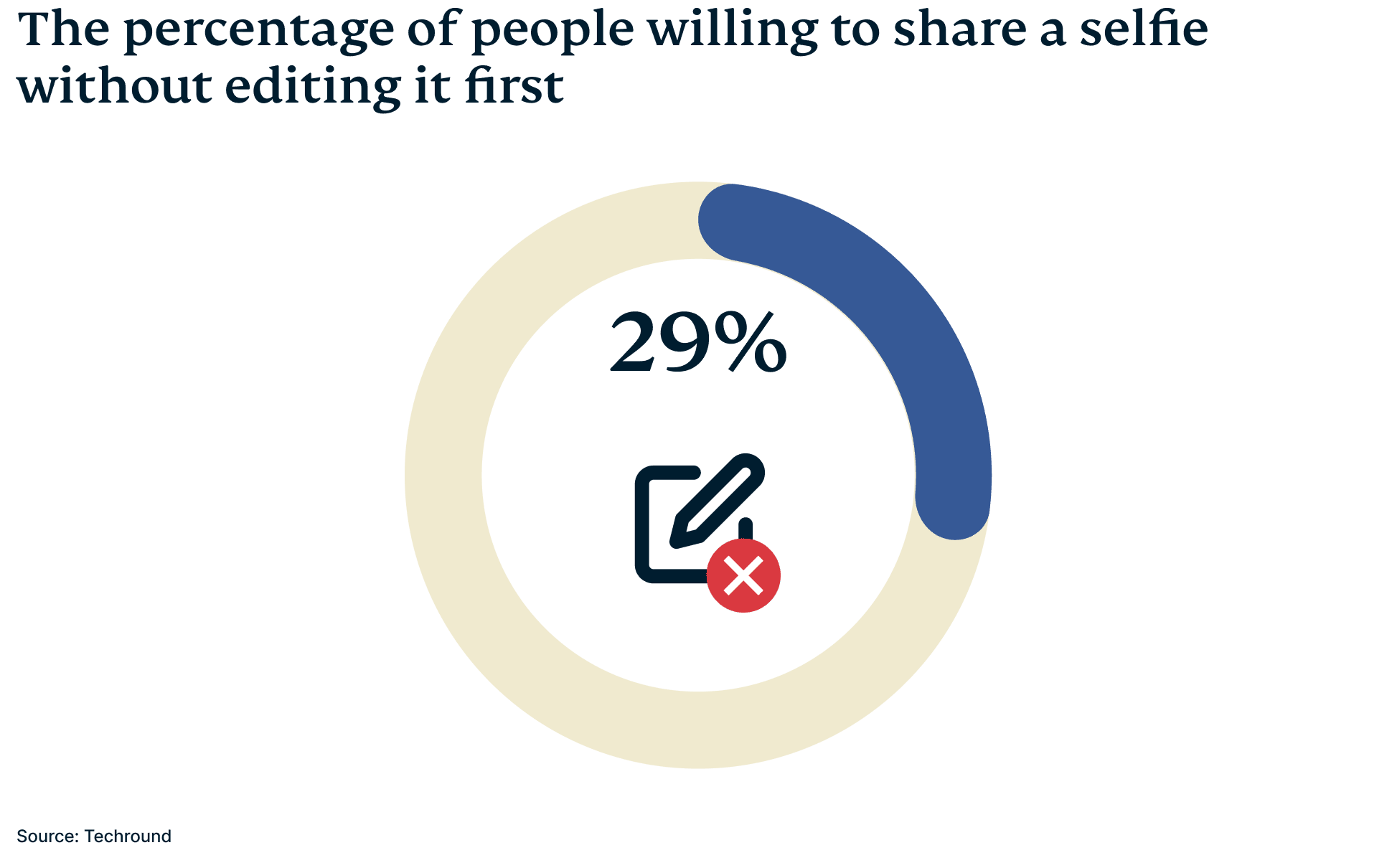
Of people who edit their selfies, about 8% use Instagram to do so, while two-thirds use the app Facetune. They do this to ensure that skin imperfections are concealed and facial features are altered.
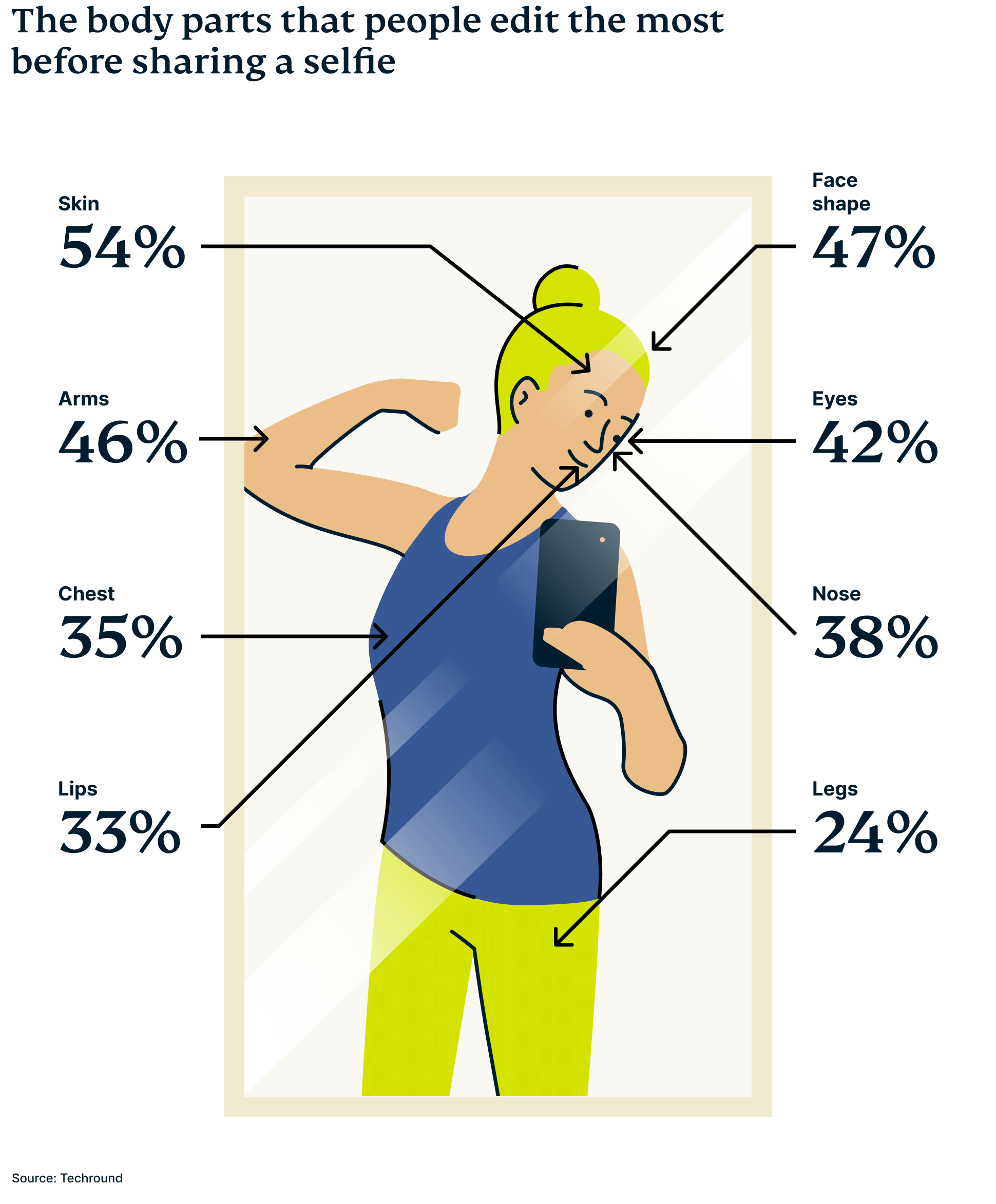
Filters also play a significant role in shaping online appearances. Both men and women admitted to occasionally using filters to enhance their attractiveness. However, women emerged as the more frequent users, with 9 in 10 admitting to incorporating filters when posting selfies on social media.
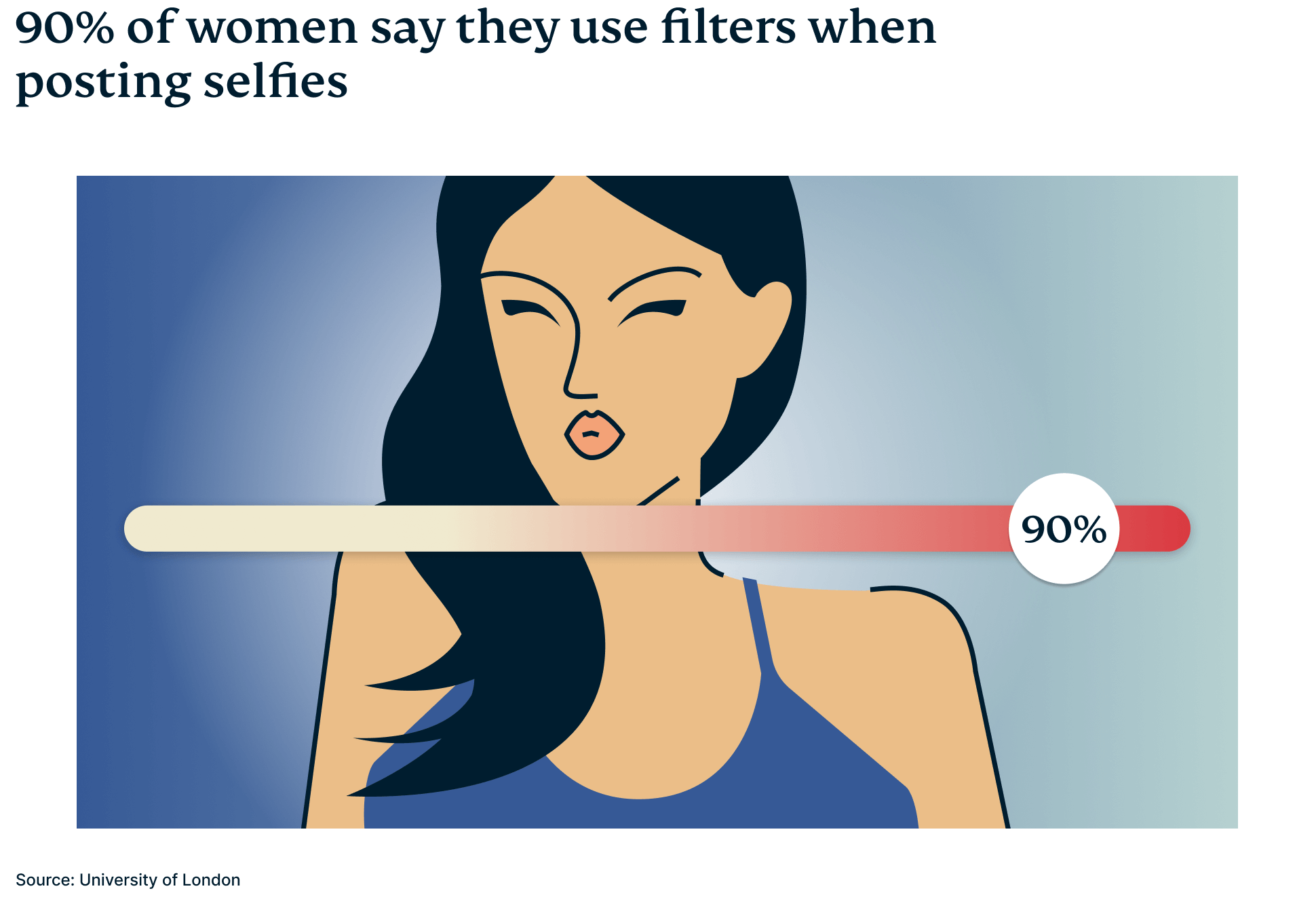
While it is undeniable that social media can foster unrealistic expectations and negatively impact mental health, it’s equally important to acknowledge its potential as a platform for self-expression and understanding. For many individuals, social media offers a space where they can freely express their thoughts, emotions, and experiences. It becomes a medium through which they can be heard and understood, potentially bolstering their mental well-being.
Therefore, the psychology of selfies goes beyond a simple narrative of narcissism. Selfies have evolved into a multifaceted form of self-expression, enabling individuals to capture and convey meaningful moments in their lives. While the influence of social media on mental health remains complex, selfies can serve as a tool for empowerment, self-reflection, and connection.
The future of selfies
In our era of evolving selfie culture, the influence of Gen Z can’t be overlooked. They have emerged as rebels, revolutionizing the art of selfies by challenging traditional beauty standards and calling for greater authenticity. The rise of trends like “0.5” and makeup-less selfies exemplifies their determination to break free from staged imagery.
As we peer into the future, it becomes evident that selfies will continue to hold a prominent position in the social media landscape, but (hopefully) with a deeper purpose. Beyond capturing moments of personal expression, selfies will likely increasingly be vehicles for promoting and supporting social causes.
Bonus: Safeguard your privacy when sharing selfies online
With the widespread sharing of selfies online, it’s crucial to be mindful of potential safety and privacy risks. Follow these best practices to protect your privacy while sharing your snaps online:
1. Disable geotagging
Most smartphones have an automatic geotagging feature that records the location where your photos were taken. However, geotagging can pose a risk to your privacy by revealing your movements and whereabouts to anyone who accesses this information. To safeguard your privacy, manually disable the geotagging option in your device settings.
2. Check what’s in the background
When taking selfies or capturing images, it's important to be mindful of the objects or locations visible in the background. Sometimes, these elements can unintentionally disclose too much personal information, potentially compromising your privacy. Avoid including personally identifiable documents such as IDs or passports in your selfies. Additionally, be cautious about sharing vacation photos on social media while you’re away, as it could alert criminals that your property is unattended.
3. Remove photo metadata
Each photo you take contains metadata, which includes details about the exact time and location where the photo was captured. If you wish to remove this data, you can do so by accessing the file properties and finding the option to remove metadata. By deleting this information, you can further protect your privacy and prevent any unintended disclosure of your whereabouts.
4. Keep your VPN always-on
A VPN keeps your IP address and location private from sites and services—including social media platforms. One of the most convenient ways to use a VPN is by getting a VPN router like ExpressVPN’s Aircove. It ensures the security of all your devices on your home network. A VPN router encrypts your internet connection on all your devices, even ones that are normally not compatible with VPN apps like smart TVs and game consoles.
Take the first step to protect yourself online. Try ExpressVPN risk-free.
Get ExpressVPN



